The French Connection: The Knights of Malta, the Scottish Rite & the Rise of the Mafia Brotherhoods Part II

“In Seville [located in Spain] there is said to be a brotherhood of thieves with a chief magistrate and captains who sell services; it has a depository for stolen goods and a chest with three keys in which the loot is kept; from this chest they take what they need to defray expenses and to bribe those who are in a position to help them when they are in trouble. They are very careful to accept only men who are strong and active and old Christians, their membership being such as agents of the law; and the first oath to which they swear is that, even though they may be drawn and quartered, they will endure it and will not inform on their companions. And so, when something is missing from the home of a respectable citizen and people say that the devil has taken it, the truth of the matter is that it is not the devil but one of these. That they have a brotherhood is certain, and it has lasted longer than the principality of Venice; for although the law has caught a few unfortunate ones, it has never been able to run down the leader of the gang.”
- Miscelanea, By Luis Zapata, written ca. 1598
[Note to reader: “Old” Christians, as opposed to “new” Christians. The latter was in reference to Muslims or Jewish converts to Christianity, by whom it was thought by the former were not to be trusted.]
Zapata’s description of this criminal society that was known as the Compagnia della Garduna, was one of the earliest descriptions of this criminal brotherhood. More enduring than “the principality of Venice,” its traditional date of origin has been established by 19th century scholars as having begun in 1417, though no written account of Garduna’s existence before 1480 can be found.
Only four years after Zapata’s account, Miguel Cervantes would write a profile of the leader of the Garduna brotherhood which launched his career as a world renowned writer. This early profile by Cervantes on the Garduna brotherhood would eventually set the stage for his most famous work, Don Quixote.
As David Leon Chandler discusses in his book Brothers in Blood: The Rise of the Criminal Brotherhoods, the Garduna Brotherhood would serve as the parent society to the Camorra Brotherhood based in Naples, the Sicilian Mafia and the American Cosa Nostra.
By the end of the fifteenth century, Spain was consolidated under one empire that extended from Sicily in the east to the newly discovered Americas in the west. During this time, Spain was the most powerful state in the world.
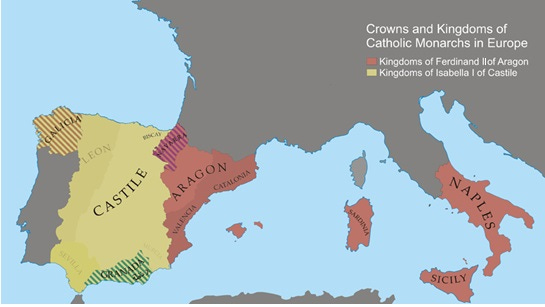
In the map above, we can see the province Sevilla to the left of Granada in Spain, this is where the city of Seville and the origin of the Garduna brotherhood is located. As we will see, one of the points of infamy surrounding the Garduna brotherhood was that they were to serve in doing the “dirty work” for the Spanish Inquisition for over 340 years. The Muslim Emirate of Granada (shown in the above map in green) was the last remnant of al-Andalus by 1469, and had come fully under the Spanish Empire by 1492 as an early outcome of the Spanish Inquisition.
Recall from Part I of this series, that the Knights of Malta, whose membership continues on today, claims continuity with the Knights of Hospitaller, a chivalric order that was founded about 1099 by the Blessed Gerard in the Kingdom of Jerusalem. Blessed Gerard was a Benedictine priest who came from the City of Amalfi.
Amalfi, located along the western coast of Italy, was also a cult center and had gained control over the Isle of Capri- a hotbed of Mithraic and Cybelian cults built up by Emperor Tiberius and maintained as a mystery cult headquarters to this day. The official emblem for the City of Amalfi became the emblem for the Hospitaller Order of St. John of Jerusalem, Rhodes and Malta, aka the Knights of Malta.
Again recall from Part I of this series that the Knights of Malta were given permanent headquarters on Malta in 1530 by the King of Spain. In return, it is said that they had to send a single Maltese falcon to the King of Spain each year on All Saints’ Day (aka Halloween) as “payment.”
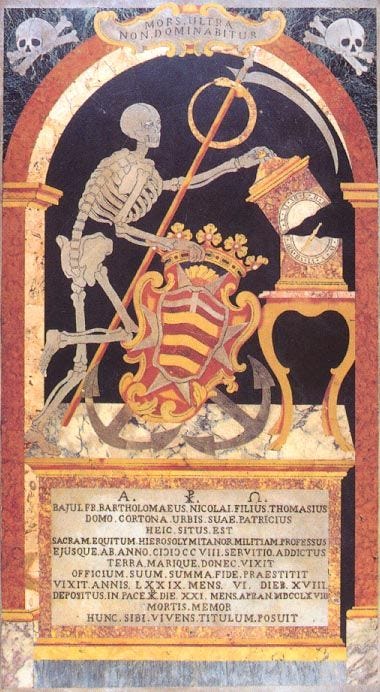
The above image is of one of the St John’s Co-Cathedral Skeleton tombstones, where we see the Maltese Coat of Arms, the sickle with the Ouroboros symbol of the snake devouring its own tail representing the eternal cycle of destruction and rebirth with a depiction of a skeleton knight stopping or breaking time.
This gives a direct and very significant relationship between the King of Spain (from the House of Habsburg who ruled as a dynasty from 1516-1700) and the Knights of Malta, who supplied them with their official headquarters.
In the previous instalment, the relationship between the Knights of Malta and the emergence of the Malta Freemasons, who were largely made up of the Knights of St. John of Jerusalem (aka Knights of Malta) and Catholic priests was also discussed in detail as well as the fact that the Malta Freemasons used the freemasonic “French Rite” at their origination, later making the shift to British Freemasonry. Also recall from Part I that the Knights of Malta had taken over the institutions of the French Templars.
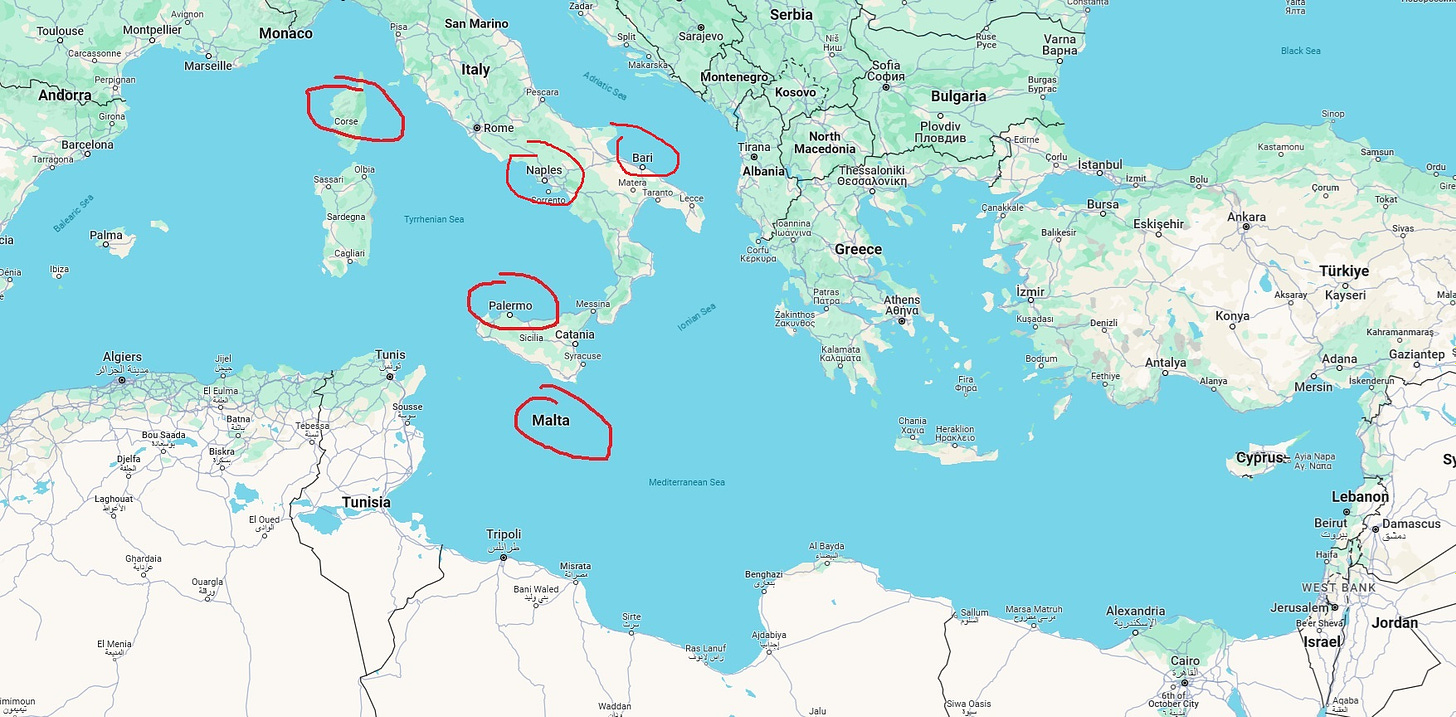
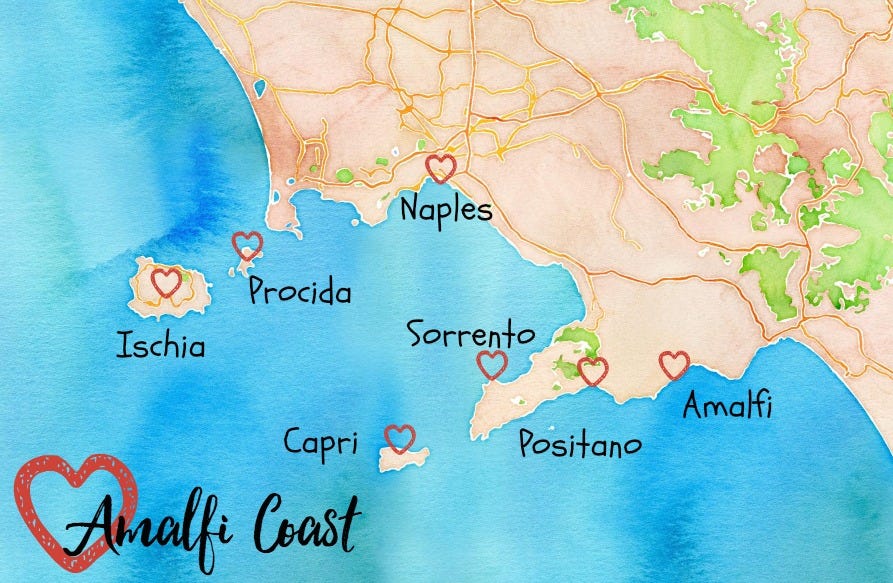
Before we get into the main story of this paper, it is best (as always) to cover a bit of history to provide us some background context.
Frederick II was King of Sicily from 1198, King of Germany from 1212, King of Italy and Holy Roman Emperor from 1220 and King of Jerusalem from 1225. He was the son of Emperor Henry VI of the Hohenstaufen dynasty (the second son of Emperor Frederick Barbarossa) and Queen Constance of Sicily of the Hauteville dynasty.
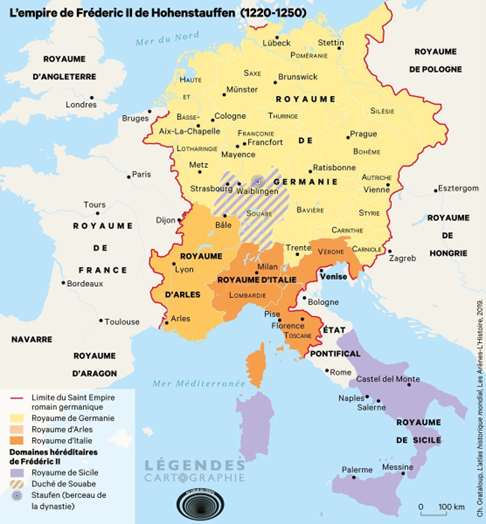
Just to give us an idea of how much change was occurring in Italy every few hundred years, here is a map of Italy in 1000 CE, just two hundred years before the rule of Frederick II.
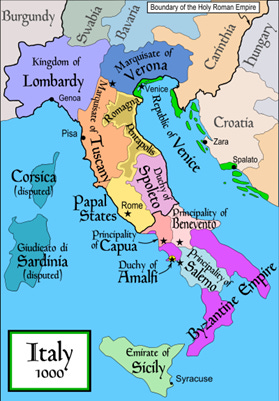
Frederick II was known as an intellectual and a patron of the arts and sciences; his cosmopolitan court united the cultures of the Christian, Muslim and Jewish worlds. Within his first year as the Holy Roman Emperor, he returned to Sicily, where he reorganized the kingdom and brought it under tight control, establishing peace in the realm.
Sicily had previously been the Emirate of Sicily under the Islamic Kingdom from the late ninth to late eleventh century. The Norman conquest of Islamic Sicily (it appears at the bidding of the Papal States) was fought from 1060-1091, many historians believe this to be the start of the Crusades.
For a period of 100 years the Normans ruled over Sicily. However, by 1194 Sicily came under the reign of the Hohenstaufens, the year Frederick II was born. Frederick II would inherit the title King of Sicily in 1198 at the age of four years old. Establishing peace in Sicily was one of his first acts as the Holy Roman Emperor. One can appreciate that it took the ecumenical approach of Frederick II to create peace in Sicily after such a turbulent history.
However, this ecumenism was not appreciated from all. “Dissension soon arose between the young Emperor and Popes Honorius III and Gregory IX for his delay in fulfilling his promise to undertake a Crusade to the Holy Land. Frederick was excommunicated by Gregory, and when he finally did depart to the East in 1228, he regained the city of Jerusalem from the Muslims by diplomacy rather than arms. After being crowned King of Jerusalem, he returned to Sicily in 1230, where he discovered and defeated the papal troops.”[1]
“From the 1230s onwards, Frederick concentrated almost solely on strengthening his position in Northern Italy. Pope Gregory rightly feared that the Papal States would be caught between Frederick's Sicily to the South and his Empire to the North.
Tensions and hostilities increased, until Gregory excommunicated the Emperor once again (1239) and the Emperor went so far as to attack Rome itself. In the following years, Frederick demonstrated his unflagging spirit by tenaciously defending his Italian interests against the ruthless strategems of the Papacy. After some reversals in 1248, Frederick was once again gaining the upper hand when, in 1250, he unexpectedly died in Fiorentino, Italy.”[2]
After the death of Frederick II, who died at the age of 56 years, the Kingdom of Naples and Sicily came under the rule of Charles I the Duke of Anjou (modern day western France). The French House of Anjou ruled as a dynasty establishing the Angevin Kingdom of Naples from 1250-1458.
However, the people of Sicily would soon after revolt against the French officialdom and taxation, and the King of Aragon (Spain) invaded and took possession of the island. Thus, the Kingdom of Sicily would be under the Aragon Crown by 1282.
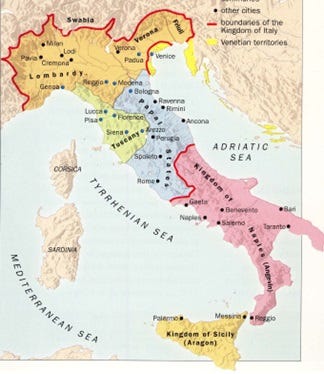
Later the Kingdom of Naples would also fall under Spanish control from the French with Spain taking full control by 1504. Malta as well would go between French and Spanish rule.
The details of this complex history are beyond the scope of this essay, however, it is just to make the point that firstly, there had been a very major disagreement between the Holy Roman Emperor Frederick II and the Papal States as to the matter of the Crusades, with Frederick II organising towards ecumenism, diplomacy and peace whereas the Papal States were pushing for Christian domination (i.e. religious and political), territorial gain and the removal of the influence of other religions and cultures.
Secondly it is to make the point that the Kingdom of Naples was under French rule for centuries before they came under Spanish rule. Italy would only be unified as the territory it is known today by the nineteenth century, including a unified language.[3]
As we will continue to see in this series, the regions that would give birth to the Mafia brotherhoods would have heavy French influence, from French Crusader Knights to French Freemasonry, as well as French rule within these regions. Thus, the French island of Corsica is not as what might first appear an exception to the rule, but rather a continuation of the very strong Knights of Malta Crusader theme (inheritors of the French Templars and members of Malta Freemasonry based in the “French Rite”) amongst the emergence of the Mafia Brotherhoods.
Servants to the Spanish Inquisition: The Origin Story of the Mafia Brotherhoods
Spain was able to consolidate itself under one empire through the marriage of Isabella Queen of Castile and Ferdinand King of Sicily and Aragon.
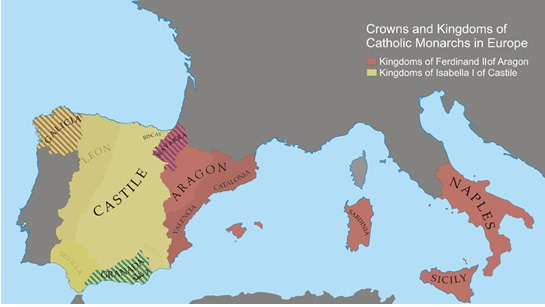
David Leon Chandler writes in Brothers in Blood:[4]
“Their marriage in 1469 was the first step toward the unification of Spain. Step two was the subjugation of Moorish Granada, an enterprise in which Ferdinand employed a number of tools. A primary tool was the Office of the Holy Inquisition. A secondary tool was the Garduna, the brotherhood described by Cervantes and Zapata.”
The Spanish Inquisition was among the three different manifestations of the wider Catholic Inquisition: which included the Roman Inquisition (overseeing the region of the Papal States) and the Portuguese Inquisition. Thus, all three inquisitions were in service to the Catholic Church but were divided into three regions for its overseeing and execution: the Spanish Empire, the Portuguese Empire and the Papal States. [The Portuguese Empire would be consolidated into the Habsburg Spanish Empire by 1580.]
Originally the inquisition in Spain was reportedly mandated to investigate those who were suspected of heresy among those who had converted from Judaism and Islam to Catholicism. However, the Spanish Inquisition intensified following the royal decrees issued in 1492 and 1502 by the joint Catholic Monarchs in Spain (Isabella I Castile and Ferdinand II of Aragon) ordering Jews and Muslims to convert to Catholicism or leave Castile – those who refused to do either would face death. This was the Alhambra Decree, also known as the Edict of Expulsion.
This resulted in hundreds of thousands of forced conversions and the mass expulsion of Jews and Muslims from Spain. The Spanish Inquisition would last for over 350 years.
David Leon Chandler writes:[5]
“The Spanish Inquisition was established by [the Spanish King] Ferdinand in 1478 to strengthen his governmental control over the peninsula. Ostensibly organized to discover whether Spanish Jews were sincere in their conversion to Christianity, it was popularly received by the general Christian population. From the beginning, however, it functioned as a secret police and a trial court answerable only to Ferdinand. Unlike the earlier medieval inquisitions in other nations, the Spanish Inquisition was under full control of the king rather than the pope. Ferdinand used it to conduct espionage among his subjects and to punish and intimidate political dissent. Held in the ever-tightening grip of the Inquisition, the commerce, arms, and populations of Spain were welded into a single weapon powerful enough to crush Granada.”
Granada was the last Muslim remnant from the days of al-Andalus.
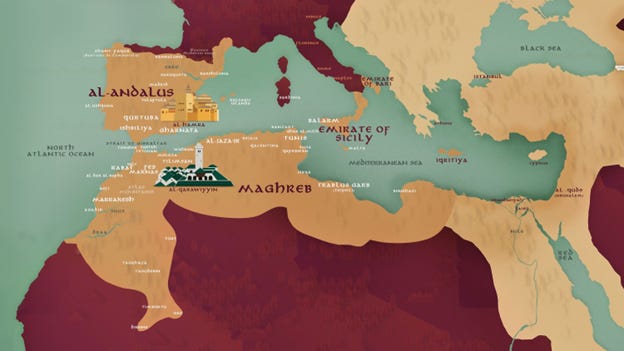
Most of Spain would be under Muslim governance for over five centuries and Southern Spain for over seven centuries. Thus, one can only imagine how the Spanish Inquisition, demanding Catholic conversion of all those living in these regions, after having lived as al-Andalus for centuries would have been received by the people living there. I would gather that it was not perceived as a return to their roots as a “Spanish” people.
The last remnant of al-Andalus, the Muslim Emirate of Granada, was eradicated by 1492 as an outcome of the Alhambra Decree of the Spanish Inquisition.
Though a detailed history of al-Andalus is essential in comprehending the dynamics of Spain at the time, it is beyond the scope of this essay to provide such an overview here, however, it is important to at least mention that al-Andalus did not demand of its inhabitants that they all convert to Islam. Rather, al-Andalus was known around the world as a place of religious ecumenism, where Islam, Judaism and Christianity could co-exist and flourish peacefully. In fact, al-Andalus was considered a renaissance hub during the Islamic Golden Age, and many scholars of all faiths would travel to the Houses of Wisdom in Baghdad and al-Andalus for their renown as being among the best knowledge centers in the world who welcomed all cultures and all faiths.
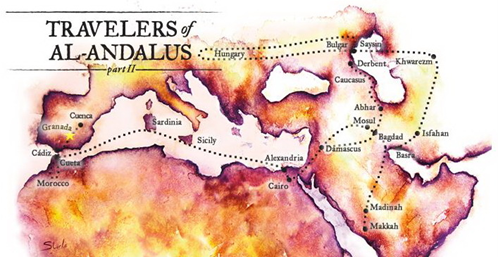
[For those who wish to learn more about al-Andalus refer to my RTF class “On Lessing's 'Nathan the Wise': Is a Harmony of Cultures Possible?”]
Gotthold Lessing, who wrote the 18th century play Nathan the Wise in response to the religious divide that thrived during his lifetime, gave the wisest response to those who wished to quarrel for all eternity or until the other religions were entirely destroyed - that the best religion (concerning Judaism, Christianity, and Islam) shall be judged on who shall produce the best fruits 1000 years from now and that until then, let us reserve our judgement.
One wonders whether that was the point of the Crusades and the Catholic Inquisitions, to attack ecumenical hubs like al-Andalus that had existed in peace for centuries before it had been decided by the Crusaders that these Muslim scholars were in fact infidels in the eyes of their Christian God. However, this did not stop the emergence of the Protestants in opposition to the Catholic rule, and centuries of war continued in Europe, now Christian was pitted against Christian.
It was always about dividing to conquer. But who was meant to be the ultimate conqueror? This is a worthy question to keep in mind throughout this series.
David Leon Chandler writes:
“The Inquisition was particularly active along the borders of Granada and it was there that the priests apparently came into contact with the Garduna, probably around the year 1480.
…
Around the year 1480, shortly after the Inquisition was introduced to Spain, the Garduna hired out its services. It was a significant union, for it brought the…Garduna into alliance with high officers in government, an advantage it would enjoy in Spain for the next 340 years.
The Garduna made commando raids inside the borders of Granada. Their harassment of villages and large estates caused tension among the Moors. Moorish troops were detached from the main army to provide garrison defenses. This guerrilla activity was of substantial assistance when Ferdinand began his military campaign against Granada in 1482. When the conquest was completed ten years later, the Garduna switched from its sanctioned raids on Moors and Jews to more stealthy predations against the entire Spanish population. It felt secure in doing this because of the liaisons built up over the ten-year period with priests, inquisitors, and royal officers.
During the war, the Garduna had been employees. After the war, the Garduna became in effect employers, buying protection from members of the government.
It also continued to sell its services, and beginning in the year 1520 the Garduna commenced to keep written records of its crimes, clients, and fees. These records would be referred to by Cervantes in 1602 and actually produced at a trial in Seville in 1822. They showed that the most frequent clients were the priests and officers of the Spanish Inquisition…Over the 147-year period covered by the record, the priests had ordered and paid for slightly more than two thousand felonies…Of the priest commissioned crimes, the carrying off of women made up about one-third. Assassinations formed another third. The balance was taken up by lesser crimes – robbery, false testimony, denunciation, and maiming.”
By 1602 the Garduna was a venerable institution in southern Spain, its headquarters were based in Seville.
One wonders if this is the reason for the focus on Seville in the famous plays by Pierre Beaumarchais, known as the Figaro plays: Le Barbier de Séville, Le Mariage de Figaro, and La Mère coupable as a trilogy set in Seville. These were made famous by the Rosini opera “The Barber of Seville” and Mozart’s opera “The Marriage of Figaro”. Mozart’s opera “Don Giovanni” is also set in Seville, its subject is a centuries-old Spanish legend about a libertine as told by playwright Tirso de Molina in his 1630 play El burlador de Sevilla y convidado de piedra.
It appears Seville’s notoriety was due to the infamous Garduna brotherhood who ruled over the people of Seville with an unforgiving system of brutal feudalism. In fact, the crimes of Don Giovanni against the Spanish people he ruled over are very reminiscent of the sort of crimes the British committed against the Irish and Scottish people during the period of William Wallace.
Seville would also be made famous through the writings of Miguel Cervantes. In fact, Cervantes had been thrown into a Seville prison when he wrote the story called Rinconete and Cortadillo, which was his first popular work. “The story is best known as the literary parent of the Don Quixote novels, but it is also the world’s earliest profile of [The Garduna] brotherhood boss, a man named Monipodio.”[6]
In this work Cervantes lays out a very detailed description of how the Garduna brotherhood functioned within Seville, as a bureaucracy of specialists presided over by a paternal dictator who gives advice, settles disputes, protects his people, and allocates rewards. Essentially, the first known account of a Mafia Godfather. In the Cervantes story, even “His Majesty [the King of Spain] gets a fifth of any treasure that is found” by the Garduna.
Detailed, too, is the business-like way in which respectable citizens commission crimes. Cervantes compares it to ordering a suit from the tailor. The citizen places his order, makes a 50-percent down payment, and the job and the fee are entered by Monipodio in a logbook.[7]
The work was a popular sensation and ended with promises of further tales, however, Cervantes never wrote a sequel. It is likely Cervantes was cautioned against a sequel for Rinconete and Cortadillo was more a satirical expose rather than a piece of fiction. “The details have proved quite accurate in every respect, down to the location of houses and the names of streets.”[8]
However, Cervantes would continue the tale in a more fictionalised metaphorical version in Don Quixote. A strong theme in Don Quixote is his obsession with becoming a knight, a knight of the Crusades, who deludes himself into thinking he is some sort of hero of the people, battling dragons and saving princesses, a warrior arbiter of noble justice.
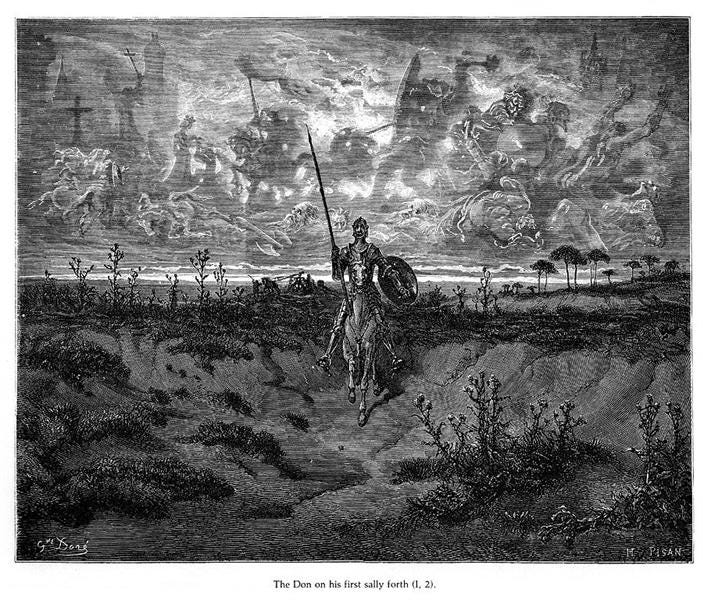
David Leon Chandler writes:[9]
“The trial was held in 1822, a few months after the Spanish government had finally expelled the Inquisition from Spain. After the Inquisition priests left, the government dispatched a troop of mountain chasseurs to exterminate the Garduna. In a surprise raid, they seized the house of the grand master of the society, one Francisco Cortina, a powerful and wealthy Spaniard and frequent guest at the royal court. In his house were found logbooks dating from 1520 to 1821.
The ledgers showed that the Garduna had main branches in Seville, Toledo, Barcelona, and Cordova, with subsidiary organizations in many smaller towns. Entries relating to the Spanish Inquisition spanned 147 years, from 1520 to 1667…The government, however, demonstrated in the 1822 trial that the Garduna’s special relationship with the clergy was continuing even at that time.
Testimony at the trial showed that the grand master had control of all profits and would divide the proceeds into three parts. One went into the general fund, to pay for bribes to judges, magistrates, governors or prisons, and other officials. Another third was reserved for contingencies such as pensions for the wives of dead or imprisoned members. The final third was turned back to the members who had committed the crime, after the boss had taken his share.
These special funds were the same as those described by Cervantes in 1602. An identical system was used by the American Cosa Nostra in the 1960s, according to US Senate committee investigations.”
Chandler continues:
“Indeed, many features developed by the Garduna have survived in to the twentieth century. One of these was the Garduna model for a hierarchy. At the top was a boss, a grand master. Beneath him were chiefs of various localities, captains, called capatazes (or in the Cosa Nostra, capos). Beneath them were a layer of specialists – commercial spies, financial technicians, expert killers. At the bottom were the soldiers, the rank-and-file membership who acted as foremen to oversee particular crimes. The crimes themselves were usually done by non-members, either novice applicants to the society or common criminals hired for a particular job.
The ledger book seized in 1822 provided the basis for conviction of the grand master and sixteen of his chief captains. They were hanged in the marketplace of Seville on November 25, 1822. The mass hangings provided a final sequel to Cervantes’ book.”
Thus, it is incredibly significant that the emergence of the first known Mafia Brotherhood, the Garduna was lifted into power and influence in return for its service to the Spanish Inquisition and played an essential role in the overthrow of the Emirate Granada, the last remnant of the ecumenical Islamic Renaissance hub, al-Andalus. The Garduna did the “dirty work” for the Spanish Inquisition for 340 years, in service to the Catholic priests and they were then given free reign to abuse the Spanish people, Catholic or not, in their mini-kingdom of Seville and beyond.
The Spanish Inquisition was the last stage of the Crusades, and very much reveals the sort of vision the Crusaders had for the world. Spain, which had fallen entirely under the yoke of the Spanish Inquisition was ruled over by a secret police state, and it was common for people to go missing and return only after a period of torture or never to be seen again. The Spanish Inquisition was not just about a religious domination, but a political domination and Catholics who disagreed with such an outlook were just as readily thrown into prisons for the rest of their lives and never to be seen again.
This bears a great deal of similarity with what we would see emerge in the 20th century under Operation Gladio, and is especially remnant of the techniques used liberally in Central and South America under Operation Condor, which was part of the Gladio apparatus.
We should also remind ourselves that it was the Spanish Habsburg’s Empire that gave the Knights of Malta their headquarters. As we will see in this series, this relationship would also be carried forward into the 20th century.
In fact, we will see that the Vatican would play a central role in Gladio, and it is not irrelevant to note that Central and South America consist almost entirely of the Catholic faith. The Mafia Brotherhoods would continue its service to the Vatican and play a central role in Vatican Gladio as well.
It would appear that the Mafia Brotherhoods had been created for that very purpose, to serve the Catholic Crusaders from the very beginning.
.
.
“In Seville there is said to be a brotherhood of thieves with a chief magistrate and captains who sell services…They are very careful to accept only men who are strong and active and old Christians…That they have a brotherhood is certain, and it has lasted longer than the principality of Venice...”
- Miscelanea, By Luis Zapata, written ca. 1598
Read Part III here.
[Part III will discuss the emergence of the Camorra Mafia Brotherhood in Naples, the Sicilian Mafia, and how Mazzini and the Scottish Rite are connected to these phenomenon, especially concerning their role within the United States during the Civil War.]
Cynthia Chung is the President of the Rising Tide Foundation and author of the books “The Shaping of a World Religion” & “The Empire on Which the Black Sun Never Set,” consider supporting her work by making a donation and subscribing to her substack page Through A Glass Darkly.
Also watch for free our RTF Docu-Series “Escaping Calypso’s Island: A Journey Out of Our Green Delusion” and our CP Docu-Series “The Hidden Hand Behind UFOs”.
Footnotes:
[1]https://www.brown.edu/Departments/Italian_Studies/dweb/history/characters/frederick_ii.php
[2] Ibid
[3] In 1861 at the time of Italy's unification, localized dialects were so widespread that only around three percent of Italy spoke what is now modern Italian. To help bring Italy together, the Tuscan version of Italian was chosen by the newly formed government to be the national language of Italy.
[4] David Leon Chandler. Brothers in Blood: The Rise of the Criminal Brotherhoods (1975). Pg. 7
[5] Ibid, pg. 7
[6] Ibid, pg. 10
[7] Ibid, pg. 11
[8] Ibid, pg. 12
[9] Ibid, pg 12

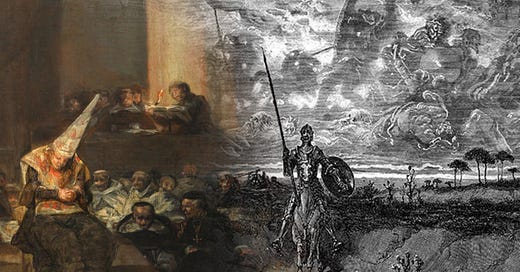


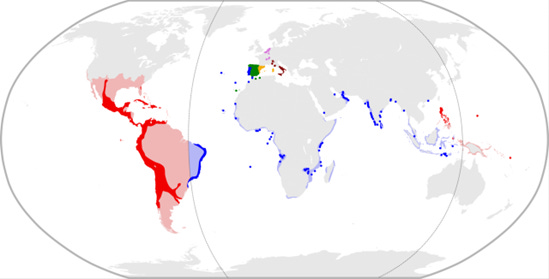

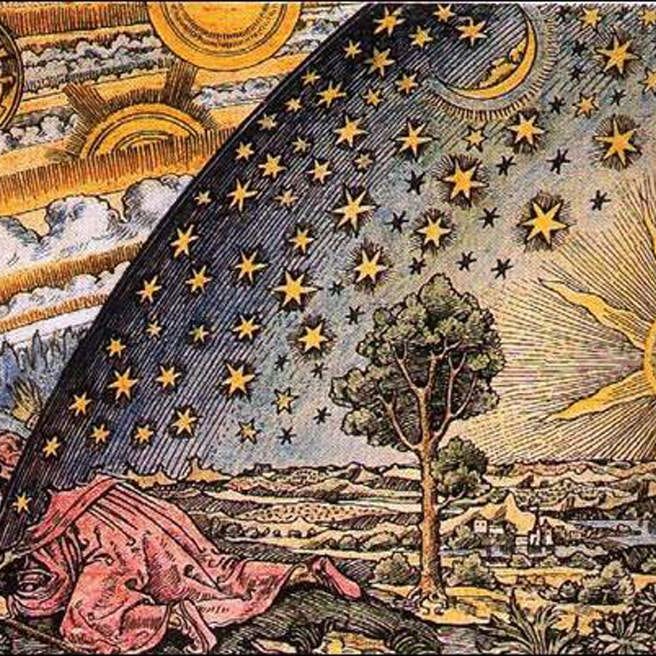
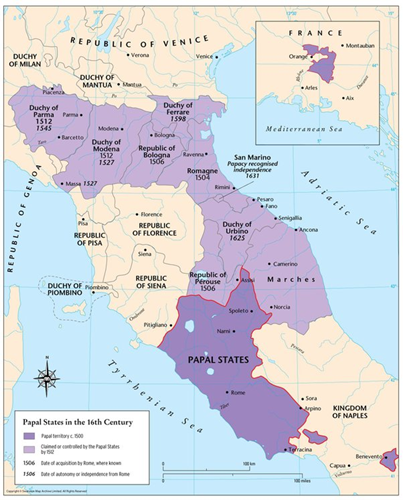
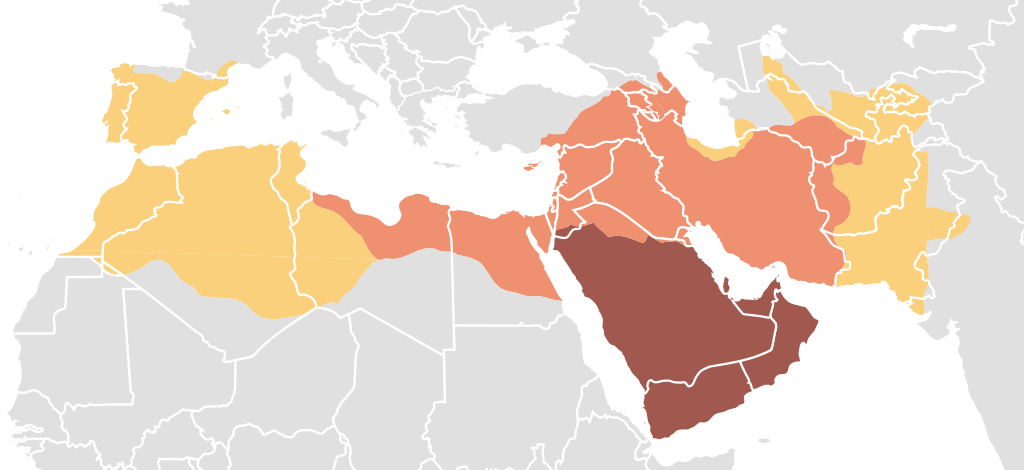

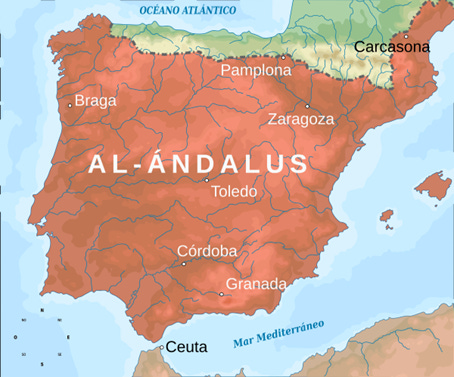


Great history lesson.
Inexhaustible and highly historically elusive powers make it hard, to say the least, to determine simply what was/is good or bad for a humble human as I consider myself. Love this series and your other enduring work! God Bless!!!